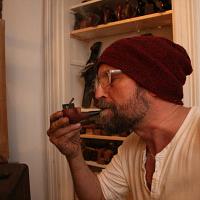
MaFe
in over 11 years
Fibonacci gauges #4: you will get the point...
This is
part 4
in a
6 part
series:
Fibonacci gauges
...
-
making the arms.
-
you will get the point...
-
rivets, branding and more…
- making the arms.
- you will get the point...
- rivets, branding and more…
Fibonacci gauges
you will get the point.
Hi again Craftisan’s.
In the last part we made gouge arm points, yes jigs and .
So this blog starts with us cutting on the table saw, this time exactly on the mark we made for the lengths.
Again in a batch, with the drill bit holding them together.
The push fish seems thrilled.
Clean cut ends, with the rods in exactly the end of them and no glue mess up.
Now you know why we did not cut them to the right length, but left a wee extra.
Next up, I try to decide on the angle for the pointed end, I like the 2-1/4, when I lay the arm against it, like this.
Using some scrap pieces to make the test cuts.
Don’t ask where I got them from…
Looking good from here.
But the centre was a wee of, so we have to fix that!
By making a stop, so it will land at exactly the same place each time.
Just shy of the line on each side, I try to saw exactly on each side of the brass rod.
I think this will be good.
First one cut and that’s as close as it gets, really happy here.
Dohhhhhhhhhhhhhhhhhhhhhhhhhhhhhhhhhhhhhhhhhh!!!
The arms are too long for the sled.
Well we can fix that, laughs.
I removed the screw before I drilled and moved it closer to the saw cut after.
Just a small adjustment…
Woodworking is all about that and that’s exactly why I love it.
Cross cut sled, with an angle block, a stop block and a little strange hole…
We can now saw all the arms to exactly the right shape. Length and angle.
Laughs, I love it!
Another jig… I’m hopeless, I know it. But this time recycle.
A piece of scrap wood are used as a fence and attached to the circle jig, with two screws.
The angle is set to exactly where the side of the point touch the sand paper.
Like so.
Now slowly sharpen the end, one side at the time.
But just as much, so you still have a wee flat at the end, app. The thickness of a nail, otherwise you will change the proportions, if you sharpen too much.
Same for the other side, still arm flat against the fence, even this creates a new angle out there.
Slowly moving in from each side, and still leaving a small flat on the top, just a tiny area.
This is what you will end up with and that’s why we made an extra jig, because getting this close on a table saw, would be almost impossible.
You can see the extra angle on the side, it gives a little more syupport for the brass rod, that’s why I did it this way.
Then carefully sand, and it will just look as a point.
Again be careful not to sand the small top, away from the end of the gauge leg.
Back to the book binding screws, leather screws, or what ever we call them.
One half goes in from one side.
Then a washer and here you can see they are too short, there will be no support for the other leg.
Why I ordered some longer from E-bay, that I am awaiting now..
Screw goes in from the top like this.
Here a longer from my ten years old gauge, this is better.
When the screws are being mounted, I will put Locktite thread locker 222 in them, so they will be fixed, but removable, but you can also just use epoxy, then you will just not be able to re adjust later.
Borrowing the screws from the old gauge, to assembly a new for now.
You can also see here, how the arms are supposed to be put on top of eachother.
And so we go.
But on one of them I out a lock washer.
On the short side arm.
And instead of the screw that comes with the book screws, I use a small knurled bolt, with a bunch of washers under.
You might make on from threaded rod, with a small wood handle on top, if you cant get one of these, I just had a few in a box.
Tadaaaaa!
We finally have a Fibonacci gauge.
In next part we will make alternative assembly methods, a kind of jig…
Hope it can be to some inspiration.
Best thoughts,
MaFe
MaFe vintage architect and fanatical rhykenologist.
2 Comments
Losing fingers since 1969
Main Street to the Mountains











































